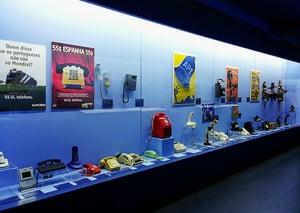Inaugurated in 2004 , when two hundred years passed after the end of the first period of operation of Mala-Posta (Lisbon to Coimbra, from 1798 to 1804), this exhibition recreates situations on a full scale associated with the transport of mail and people in one of the calls molting seasons, between the end of the 18th century and the beginning of the 19th century . The figures of employees and passengers seem to have been immobilized at a time when time has stopped and, in the next instant, they will return to their normal lives.
Mala-Posta emerged in Portugal as part of the extinction process of the Correio-Mor Office, which for about two centuries was in the possession of the Gomes da Mata family, after which it was exploited by the State in 1797.
At that time, in most European countries, post offices on foot or on horseback had already given way to carriage transport and also covered passenger transport.
It was José Mascarenhas Neto, when he was appointed to the post of General Superintendent of Postal and Post Office, who instituted the Mala-Posta service. He is the author of the «Method to build the Roads of Portugal» and the «Instructions for the establishment of the Diligences between Lisbon and Coimbra». This regulation established, in addition to the rules of conduct that involved personnel and passengers, the routes, stops and respective schedules in the «Inns» and «Casas de Posta», which should be marked with the Royal Weapons.
With António Fontes Pereira de Melo at the head of the Ministry of Public Works, from 1852 onwards, major remodeling of the communications services took place. The «Mac-Adam» method is used on the Lisbon-Porto road, new French carriages and new horses are purchased. The molting stations also undergo changes, having a typified architectural style and also serving for travelers to dine and stay overnight.
In 1859, the connection between Lisbon and Porto through the careers of Mala-Posta took 34 hours and passed through 23 seedling stations.
Despite the good service that the diligences provided at that time, its extinction was irreversible with the appearance of the train, although they remained in activity for some time, as attested by the “Traveler’s Manuals” of the time.
Portuguese Communications Foundation
The Communications Museum , opened in 1997 at Rua do Instituto Industrial, 16, in Lisbon , is a pedagogical space of scientific and technological nature, where, in a playful and interactive way, you can have access to information about the past of communications and also about the technologies of the future. The Communications Museum belongs to the Portuguese Communications Foundation – FPC , and is responsible for the museological collection of its founders ( ANACOM , CTT and Portugal Telecom ) and for its dissemination.
Located in the riverside area of Lisbon, The Portuguese Communications Foundations (FPC) was created in 1997 by the founding members ANACOM, CTT and MEO.
The FPC is the guardian of Portugal’s communication heritage and its chief purpose is to conserve and divulge it. It also aims to assert itself as a nationally and internationally recognised cultural and scientific institution that plays an active role in promoting citizenship, literacy, learning and social inclusion.
The existing heritage includes a valuable collection of pieces ranging from the 16th century to the present day.
This heritage is grouped into the Postal, Telecommunications and Art and Philately collections. It can also be consulted in the Historical Archive, Iconography Archive and the Library, and online in the Digital Catalogues.
The Museum of Communications is an active and visible part of the achievement of the Foundation’s purpose. It holds exhibitions on the science and techniques linked to the sector, allowing visitors to learn about its history and to experience the future of technologies, highlighting the permanent exhibitions Overcoming Distance – Five Centuries of Communications in Portugal, Mail Coach and the House of the Future in the Cloud – Living in a Smart City, as well as exhibitions of contemporary art.
The Foundation is therefore a place in which the past, present and future of communications are intertwined. It is a platform for innovation and experimentation in new technologies and their impact on the way people organise and live their daily lives.





